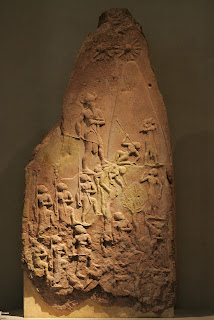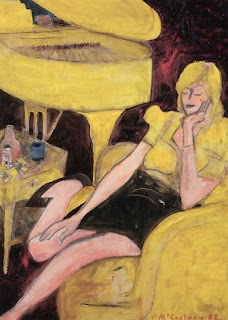Wednesday, October 13th, 2010
Naram-Sin Inscriptions
Bah! I found another problem with something in Stokstad’s recent Art History text. I promise that I’m not spending my time scouting out errors in this book – they just happen to pop up. I like a lot of things about Stokstad’s approach to art history, but these minor errors and misleading statements are making me question whether I want to use this textbook for my classes. (Plus, it’s making me wonder: what other incorrect or misleading statements in the text could have escaped my notice?) Man, if I ever decide to give up teaching, maybe Pearson Prentice Hall would hire me as an editor for their future editions of Art History.
Right now I’m bothered about Stokstad’s discussion of the Victory Stele of Naram-Sin (2254-2218 BCE, shown left). Stokstad writes about the significance of “the inscription” on the stele – which suggests that there is only one inscription.1 In reality, though, there are two inscriptions: one that was written by Naram-Sin, and another inscription (which is most prominent and recognizable) that was written about 1,000 years later. Not only does Stokstad fail to recognize that there are two inscriptions, but she also implies that the second (clearly visible) inscription is the one that was written to commemorate Naram-Sin’s victory. This simply isn’t true.
To prove my point, let me show you the inscriptions. Here’s a detail image of the first inscription that was made:
In regards to this stele, I liked Feldman’s discussion of how Shutruk-Nahunte chose to associate himself with Naram-Sin in the second stele inscription. Feldman writes, “That Shutruk-Nahhunte did not overwrite or obliterate Naram-Sin’s original inscription, as he did with other captured Mesopotamian monuments, and moreover, that in his own inscription he attributed the stele to Naram-Sin by name, suggests that this particular monument possessed a significance beyond simple war booty. Rather, Shutruk-Nahhunte’s knowledge of the stele’s association with a charismatic, if dishonored, ruler of the first great Near Eastern empire imbued the monument with added value.”2 It’s neat to think about how the value and meaning of this stele has changed over time.
Anyhow, thanks to Marian H. Feldman, I’ve now got my two inscriptions straight. Let’s hope that Stokstad straightens out her own error in future editions of Art History.
1 Marilyn Stokstad and Michael W. Cothren, Art History, 4th edition (Upper Saddle River, New Jersey: Prentice Hall, 2011), 36.
2 Marian H. Feldman, “Knowledge as Cultural Biography: Lives of Mesopotamian Monuments,” in Dialogues in Art History, from Mesopotamian to Modern: Readings for a New Century, Elizabeth Cropper, ed. (London: National Gallery of Art, Washington, 2009), 44.






